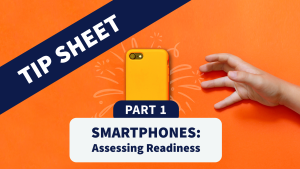
Ownership of a smartphone is one of the biggest rites of passage for today’s youth – in most families, the question of introducing a smartphone has become less about “if” to introduce a smartphone to a child than “when” and “how.” Parents and caregivers worry, appropriately, about opening up the unmediated world of social media apps and internet content to their child. When is the right time? What should families know about how to assess child readiness for a smart device?
Children and Screens convened a panel of media experts, child safety advocates, parenting coaches, and communications researchers to answer the essential questions for parents and caregivers around smartphone introduction. (Keep your eye out for other tip sheets in this series: Smartphones: Preparing for Healthy Use, and After the Smartphone: What Now?)
Smart Devices – Which One To Introduce?
Consider Introducing A “Less Smart” Device First
The prevalence of smartphones may lead some parents to believe that their child should go straight from no device to a smartphone. Experts caution against this all-or-nothing thinking. Elizabeth Milovidov, PhD, JD, Founder of DigitalParentingCoach.com, urges parents to think about another introductory device first. “Does your child actually need access to the web? They may not if it’s just for phone calls and for texting – a flip phone will work quite well.”
Safety concerns are another reason many caregivers introduce a smartphone. Stephen Balkam, Founder and CEO of the Family Online Safety Institute, suggests instead introducing a device like a smart watch, which can offer the child the ability to make a call, text, and in some cases take a photograph but are not open to the Web and do not allow the download of social media apps. “Get them something, a device that they can wear that looks cool, that allows them to communicate with a certain number of friends and family members, but doesn’t open them up to everything that the web has to offer,” says Balkam.
Beware The “Pass Back” Smartphone
Just because a parent may need an upgraded phone does not mean that their child should gain access to the older model, cautions Balkam. “Far too often I’ve seen what we call the ‘pass-back iPhone’, when Mom or Dad are driving kids around, they just pass their old phone to the backseat, and the phone never comes back to the front seat again because Mom and Dad have gone and bought a new one. So now the kid has gotten an old iPhone. But guess what? There are no controls on it, and we’re seeing kindergartners, first- and second-graders showing up to school with $1,000 devices,” says Balkam.
When Is The Right Time To Get A Smartphone?
Work As A Community To Set Standards
“I know how isolating it can be to be a parent when a child constantly is saying to you, ‘Everyone in my class has an X, Y, or Z.’ There’s a really interesting organization called Wait Until Eighth, which is the concept of waiting till eighth grade to get your kid a smartphone. And you do that through a sort of social contract with other parents in the school. So that’s a real help for parents who are feeling isolated or under a lot of pressure,” says Balkam.
Elizabeth Englander, PhD, Director, Massachusetts Aggression Reduction Center; Professor of Psychology, Bridgewater State University, says this community approach works for more than just smartphones. “I’ve seen some wonderful experiences with parents who get together as a group to enact limitations and or to consider together as a group how to do things, like when should we let all our kids get an Instagram account, or when should we get them a smartphone? And doing it as a group really helps. It really gives you as a parent some backup.”
Developmental Signs Of Readiness – Responsibility
So what might be individual behavioral or developmental signs that a child or adolescent is “ready” for full access to the Web and social networks that a smartphone offers?
“A huge one is a kid either transporting themselves around your local community on transit or bike independently beyond your neighborhood,” says Devorah Heitner, PhD, author of Growing Up in Public: Coming of Age in a Digital World. “A kid who’s taking three buses, a kid who has sibling care responsibilities after school, a kid who’s getting paid to babysit other kids, a kid who’s going to be home alone” – all these situations demonstrate a level of responsibility that indicate possible readiness or need for a smartphone, especially if the child doesn’t have access to a landline for emergency uses when home alone.
Other demonstrations of responsibility, like a child taking on daily ownership of making their own lunch is also an indicator they may be ready for more access to digital media, says Heitner.
Englander agrees progressive responsibility-taking can be coupled with increased device privileges. “It’s a good idea to marry together the concept of privileges and responsibilities – the idea that as you have more responsibilities, you have more privileges, and those two things increase and decrease together. So, as you get older, you may have the privilege of having a device, but you’re going to have more responsibilities too, sort of ‘Nothing in life is free.’”
Meryl Alper, PhD, Associate Professor of Communication Studies at Northeastern University, suggests parents think about all the small daily types of responsibilities involved with smartphone ownership – and help children demonstrate and practice the ability to handle them. “What are the scalable, scaffolded approaches to responsibility that lead up to a phone?” asks Alper. “How do you scaffold and practice those other forms of responsibility – not just the charging of the phone, but everything that comes with it in the smaller, lower stakes ways?”
Behavioral Signs Of Readiness – Emotional Regulation
Beyond responsibilities, experts agree that demonstrating good emotional regulation in social situations can be a precursor to an ability to handle the increased access to the world of apps and social media on phones.
Englander shares one situational indicator of emotional readiness for a smartphone – how the child handles conversations about getting a smartphone and the potential rules around its use. “In our research, one of the things that we have found [that indicates readiness] is when kids are able to handle conversations about having their own device,” she says. If a child is calm and respectful and understands that there need to be rules around smartphone use, “those are all good indications that a child is more ready,” says Englander.
On the other hand, if a child becomes overly emotional or angry when talking about future limits of use for a potential smartphone, Englander says “they might not have the emotional regulation yet to really handle this very complex device.”
Milovidov further urges parents to think about whether their child would be able to handle things that have been said or not said in text messages and social apps, and to consider whether the child understands privacy, can handle time management, and has enough social skills to address what they might encounter online.
Consider The Needs Of Your Unique Child And Family
Individual children may have unique use cases or considerations to keep in mind when considering when to introduce a smartphone, says Alper. “Kids are diverse in many ways,” she says. “There’s lots of considerations when it comes to their relationship to phones. For example, there might be kids who are separated from their parents for various reasons, kids with divorced or separated parents, kids whose parents work in another country in order to support their household. And so there’s some remote parenting happening. It’s really on many levels not one-size-fits-all when we think about the intersections of things like country of origin, race, gender and so forth.”
Special Considerations For Neurodivergent Children
Children with neurodivergence – a catchall term for those not neurologically “typical” that includes several conditions such as autism and ADHD – “can come with both strengths, like unique approaches to problem solving, and challenges, such as with social communication and a heightened risk of anxiety,” says Alper.
For neurodivergent children, “how they use these tools can vary significantly depending on lots of factors, whether it’s co-occurring conditions, like if they rely on speech alone to communicate or if they also have an intellectual disability,” says Alper. “One kid in my research actually prefers talking on the phone than texting because the social cues are much richer and easier to comprehend via voice than texting.”
The challenges around neurodivergent children and device use are not limited to the specific biological and neurological situation of the individual child, but also the physical and social environment that can itself be disabling or challenging for these youth, says Alper. Alper cites research showing that autistic children want to make and maintain friendships, but that can become much more difficult in middle school with increased social stigma from peers, just when smartphones might start to be considered.
Alper suggests keeping the unique needs of each neurodivergent child in mind when considering when and what type of smart device to introduce. Consider factors such as:
- Safety – “Parents might have valid concerns about their autistic child not being able to be located, finding themselves in a very dangerous situation that the parent isn’t there to see. Being able to locate them might not be being a helicopter parent, but it could be legitimately lifesaving.”
- Sensory sensitivities – “An autistic child might have sensory sensitivities that can make wearing a smartwatch challenging.”
- Accessibility – “A phone might not just be for social purposes, but also task lists, calendars, reminders – that’s important for kids with ADHD and for speaking too. So how do you support success?”
- Agency – “Kids with disabilities have a lot of decisions made for them, so it’s really important to find ways to give them choices and respect their agency and how they present themselves online and what interest they’d like to pursue.”
- Challenges with privacy settings – “Research shows that while adolescents on the spectrum might actually be more risk averse than non-autistic peers, they also have more challenges in navigating privacy settings, such as blocking unwanted contacts. One tip is to continually review privacy and safety settings and do it together. It’s not just the one time that you get the phone or you give it to them. For example, notifications – knowing how to turn notifications off and those notifications potentially bringing unwanted material to a kid.”
- Digital literacy tailored to their interest areas – “If the child has a focused interest as some kids on the spectrum do, can you utilize that interest to be like ‘Okay, you’re really interested in finding information about this one particular fandom online? How do we navigate those communities online? How do we search for that material? What apps on your phone are you using to connect with those people?’ Doing it through the lens of that interest is going to be much more useful than in this general abstract way.”





